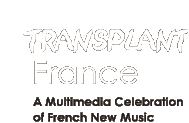Overview
Act
I
Act II
Act III
Act IV
Schedule
Partners
|
| |
CONCEPT
Sailors and seafarers find their bearings at sea by means of natural points of
reference located along the coast. These points, for example church spires, hills,
water-towers or lighthouses that generally stand out from the rest of the coastline,
are called amers [seamarks or landmarks]. All you have to do is identify three
such landmarks in complementary directions so as to be able to construct a triangle
which inevitably contains your ship. This triangle drawn on the navigation map
is called the "triangle of uncertainty."
The sound installation principle Le triangle d'incertitude takes up the principle
of triangular navigation substituting these visual seamarks with acoustic "landmarks" – also
information elements used in navigation – that can be recognized by listening
carefully. Lighthouses, buoys, ship's radio and many other technical facilities
warn the sailor of hazards or obstacles.
This installation project is concerned with constructing a triangle of uncertainty
on the ground of a fictive, virtual space on the basis of sound recordings made
at the following locations: the southern tip of Ireland [Fastnet Rock], the western
edge of France [Brittany], and the westernmost point of Spain [Cap Finisterre].
In essence, the installation refers to the position of sounds in space, constantly
chopping and changing between orientation and uncertainty.
REALISATION
The recordings play an important role for the conception of the work and are
made by Cécile Le Prado. Both pre-selected sounds are recorded, such as
a lighthouse foghorn or the whistle of a buoy out at sea, as well as sounds discovered
coincidentally during recording. The sounds are recorded because of their extraordinary,
innate acoustic and musical qualities which gives the recording a very specific,
irreversible three-dimensional image. One example is water gushing through a
hole in the pier in the port of Malpica in Spain. Owing to its musical aspect,
this sound resembles a reworked studio sound, albeit maintaining its typical
harbour quality. The history of the recording also plays an essential role during
composition work in the studio, for although the ear is indeed stimulated at
this particular moment, certain recollections of the circumstances, visual and
other impressions will actually decide on what nature the installation will assume
at a
later point.
In the studio the recorded sounds are digitally sorted and cut, and some of them
are reworked before taking their place in a kind of storyboard. This reworking
is often triggered by a harmonic or temporal quality [to widen the concept of
rhythm], a quality that already existed when the original recording was made.
By simulating an acoustic space in real time and by selecting the paths these
sound sources take in this space, what is created is an "écriture
de la spatialisation," writing for spatial recording, as an element of composition.
It is gradually refined by repeated listening and modification.
This work was created with the aid of the Spat® spatialisator. This newly
developed software by IRCAM and the Atelier Espaces is a virtual acoustic processor
that is essentially based on a perceptive analysis of space. With the aid of
the Spat®, this construction simulated in the studio can be adapted to meet
the requirements of various playback sites.
The final stage of realisation consists in integrating the installation implemented
in the studio into an outdoor or interior setting. The interplay between the
composition, the "natural" acoustic environment and the acoustics of
the installation site is always very interesting. Certain aspects of the studio
composition vanish, while others become more important. The site develops and
gradually takes on the form of the suggestion made in the studio, particularly
depending on the time of day, weather conditions, etc. The interaction of a given
site and installation determines a specific combination of restrictions and options.
In this sense, the "triangle of uncertainty" is extremely constraining.
It is heard under very precise conditions. The loudspeakers have to be equidistant
to each other and set up in a circle. The ideal space of perception, in which
the spatial effects can actually be perceived, is limited to a relatively small
area within
this circle.
Credits
Musical arrangement: Cécile Le Prado in the IRCAM studios [Institut de
recherche et de Coordination Acoustique Musique]
Scientific adviser [Spat®]: Jean-Marc Jot
Master mixing adviser: Frédéric Prin
Sound men: Mar Pazos Oviedo, Christian Dubet
The sound installation "Le triangle d'incertitude" is a production
of Clameurs, realised and transmitted by "l'autre rive".
Co-production: Centre National Dramatique et Choréographique Le Quartz
de Brest, Etablissement Public du Parc et de la Grande Halle de la Villette.
Sponsored by AFAA [Association française d'action artistique], Audio 33 – Amadeus
Concept.
|
|
Cécile Le Prado
Born in 1956, Cécile studied music and electroacoustic composition
at the conservatory of Nantes (France). She has worked at INA-GRM and at
Ircam, among other places. She has composed music for choreography as well
as films by Robert Cahen, Christian Boustani, Jean-Christophe Ballot...
In 1996 at the animation festival Imagina, she won the best soundtrack
award, for "Bruges" by Christian Boustani. In addition to numerous
acousmatic pieces and compositions for radio broadcasting, Cécile
has extensively studied architecture and soundscapes. She has created sound
installations in many places, including "Le Passeur", at the
parc de La Villette in Paris and the parc de l'Orangerie in Nice, as part
of the Manca festival. In 1996, she created the installation "Le Triangle
d'incertitude", which premiered at the Quartz in Brest (France), and
then presented at La Grande Halle de la Villette et in Ircam in Paris (CD
collection Ircam 005). Cécile's composition is a musical work, a
metaphor of real soundscapes, both a pretext and the starting point of
an inner journey. She suggests multi-scapes and border-sounds, to be explored.
|
|
|
|
|
